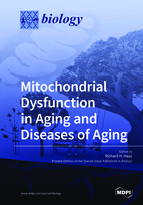Mitochondrial Dysfunction in Aging and Diseases of Aging
A special issue of Biology (ISSN 2079-7737).
Deadline for manuscript submissions: closed (30 November 2018) | Viewed by 198459
Special Issue Editor
Special Issue Information
Dear Colleagues,
Mitochondria have been increasing recognized as important players in the aging process. Most aging related diseases and particularly neurodegenerative diseases have mitochondrial involvement. A PubMed search for mitochondria and aging lists 348 articles in the first seven months of 2018. This is not surprising as mitochondria are involved not only in energy production through oxidative phosphorylation but also play an important role in intracellular homeostasis, calcium balance and the metabolism and interconversion of our dietary substrates; fats, proteins and carbohydrates in the fed and fasting states. They have an important role in signaling their metabolic state to the nucleus, and to other cells and in the response to stress. Mitochondria have their own protein synthetic apparatus and replicate themselves, pathways readily disrupted in disease and aging. They are constantly involved in fusion and fission the balance of which is essential for cell health. These organelles participate in apoptosis, they make most of the cell’s free radicals and they are crucially important for innate immunity. Mitochondrial DNA has an estimated 10-fold greater mutation rate than nuclear DNA and less repair capacity, this plays an important role in aging and cancer. Mitochondria are impacted by environmental factors and toxins and different mtDNA haplogroups originally adapted to geographically different origins make an important background contribution to disease. As mitochondria play a critical metabolic role in all organ systems they are particularly impacted by disease and contribute to the aging process itself. The invited review articles in this special supplement cover most of the common diseases of aging. Enthusiasm for this supplement in Biology is driven by the opportunity to review the current state of knowledge about the role of mitochondria in the aging process. The international group of contributing authors include many of the leaders in their fields.
Prof. Dr. Richard H. Haas
Guest Editor
Manuscript Submission Information
Manuscripts should be submitted online at www.mdpi.com by registering and logging in to this website. Once you are registered, click here to go to the submission form. Manuscripts can be submitted until the deadline. All submissions that pass pre-check are peer-reviewed. Accepted papers will be published continuously in the journal (as soon as accepted) and will be listed together on the special issue website. Research articles, review articles as well as short communications are invited. For planned papers, a title and short abstract (about 100 words) can be sent to the Editorial Office for announcement on this website.
Submitted manuscripts should not have been published previously, nor be under consideration for publication elsewhere (except conference proceedings papers). All manuscripts are thoroughly refereed through a single-blind peer-review process. A guide for authors and other relevant information for submission of manuscripts is available on the Instructions for Authors page. Biology is an international peer-reviewed open access monthly journal published by MDPI.
Please visit the Instructions for Authors page before submitting a manuscript. The Article Processing Charge (APC) for publication in this open access journal is 2700 CHF (Swiss Francs). Submitted papers should be well formatted and use good English. Authors may use MDPI's English editing service prior to publication or during author revisions.
Keywords
- Mitochondria
- Human
- Aging
- Aging Diseases
- mtDNA







